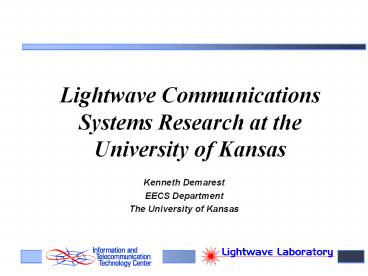Lightwave%20Communication%20Systems%20Laboratory PowerPoint PPT Presentation
Title: Lightwave%20Communication%20Systems%20Laboratory
1
Lightwave Communications Systems Research at the
University of Kansas
Kenneth Demarest EECS Department The University
of Kansas
2
Lightwave CommunicationSystems Laboratory
- Our Mission is to . . .
- Increase the capacity utilization of long
distance lightwave communications networks - Train the next generation of engineers in the
field of lightwave systems - Conduct research and publish results that
contribute to the knowledge base in the lightwave
arena - Provide value to local industry relating to the
application of lightwave technologies - Establish and maintain a core competency in
lightwave systems techniques.
3
Lightwave CommunicationSystems Laboratory
- The only state-of-the-art lightwave systems
research laboratory in Kansas - Supported by Sprint, Lucent Technologies, NEC
Corporation, the National Science Foundation
(NSF), and the Kansas Technologies Enterprise
Corporation (KTEC) - Conducts research in a variety of areas including
wavelength-division multiplexing (WDM), solitons,
polarization-mode dispersion (PMD), photonic
switching.
4
Laboratory Infrastructure
- Started Jan. 96 (20 months ago)
- 600 ft2 laboratory space
- Key test equipment includes
- 12 GHz BERT, Tunable Laser, 50 GHz Scope
- Polarization Analyzer, Optical Spectrum Analyzer
- Lucent FT-2000 8-l WDM system
- Ciena 16-l WDM system
- Soliton generator (built at KU)
- Recirculating loop (built at KU)
- Optical Clock Recovery (under development)
5
Background
Founded in Spring 1996
Support 2,033,118 (Total) NSF - 210 K/yr
through 99 KTEC - 135K/yr through 99
Sprint, Lucent, NEC - 1M/yr through 99
Its purpose is to
Identify, characterize, develop, and recommend
technologies that will expand the capabilities of
the long-distance fiber networks
Evaluate the merits of new optical networking
technologies
Promote university/industry interaction
(NSF/KTEC)
6
Participants
- Faculty
Ken Demarest (WDM Systems, Solitons) Chris Allen
(WDM and Coherent Systems) Victor Frost (ATM,
SONET, Networking) Joseph Evans (ATM,SONET,
Networking) Karen Nordheden (Devices) Rongqing
Hui (WDM Systems, Devices)
- Postdoctoral Fellow
- Coming in November
- Students
9 Graduate, 1 undergraduate
7
Major Results and Technology Transfer
- Modulator Patent Application
- Three Papers Photonics Letters (2), JLT (1)
- Two Presentations Accepted for LEOS97
- Experimental Study of Four-Wave Mixing in
Non-zero Dispersion Fiber - Interactions Between Solitons and NRZ Signals in
WDM Networks - Technical Reports
- Modeling PMD In Optical Fiber Links
- Service Survivability of Fiber Networks Photonic
Networks, SONET and ATM - Evaluation of WDM System in SMF and DSF
- Fiber link simulator delivered to Sprint
8
Current Research Areas
- High Speed Time-Division Multiplexing (TDM) and
Solitons - Optical Switching
- Modeling and Measurements
- Polarization Mode Dispersion
- Optical Networking
9
Soliton-based Transmission Systems
- Goals
- 1. Increase optical fiber transmission capacity.
- 2. Soliton-transmission related all-optical
switching and processing. - What weve done
- Built soliton generator
- Assembled a recirculating loop
- Demonstrated preliminary soliton transmission
- What were planning to do
- Dispersion-managed soliton/WDM transmission
- Soliton/NRZ hybrid transmission
- Soliton all-optical switching
10
Optical Switching
- What weve done
- Reviewed technical literature of optical
switches. - Performed experiments with applications involving
optical switching devices. - What were planning to do
- Investigate clock recovery devices.
- Research space switches.
- Investigate optical switch applications in
all-optical networks.
11
Modeling and Measurements
- What weve done
- Developed high fidelity model for fiber transport
- Applied model to address WDM over DSF issues
raised by Sprint - Model has also been used by Sprints Network
Planning group - What were planning to do
- Use this capability to address network issues
12
PMD Compensation
- What weve done
- Investigate PMD compensation schemes
- What were planning to do
- Develop an improved PMD compensator
13
Future Efforts
- Continue development of lightwave system model
- Virtual transport networks
- optical and information transparency
- survivability
- Bidirectional networks
- Continued hardware development of dispersion
managed and soliton systems - Explore optical switching technologies and
all-optical clock recovery techniques

